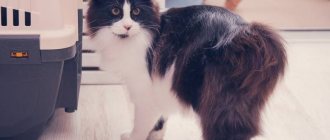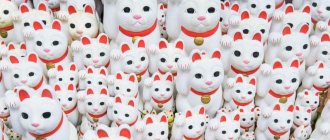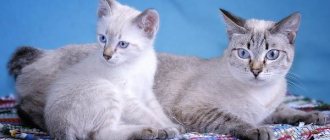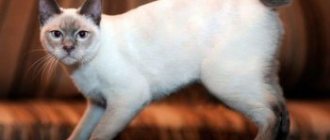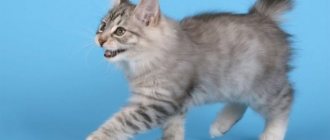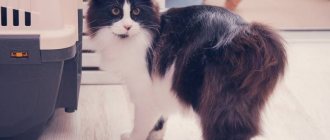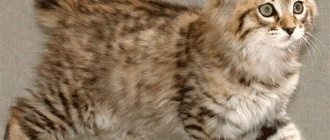Once upon a time on an island there lived a large fluffy cat with a pom-pom tail, strong hind legs like a hare, and the habits of a dog - this is how the story begins Kurilian bobtail. The cat lived on the archipelago between Siberia and Japan. The harsh conditions made her a master of survival. Local residents coexisted peacefully with packs of wild cats and valued the animals as excellent rat catchers. Many years have passed since then, Kuril Bobtails have become pets, but today they remain dexterous hunters.
General description of the Kuril Bobtail breed
Kurilian Bobtail
cat can be called a “lynx in miniature.” Approximately the same body structure, the same smooth movements, a short stubby tail, a characteristic pockmarked coat color - all this is a smaller copy of a wild predator.
The Kurilian Bobtail has:
- muscular and compact body of medium size,
- smooth curves of the body,
- the head is shaped like an equilateral triangle with roundings,
- the forehead smoothly transitions to a straight nose,
- low cheekbones,
- full cheeks,
- strong chin.
Body structure:
The hind legs of bobtails are noticeably longer than the front ones.
The body of the animal is strong, but not rough, slightly elongated. The limbs are of medium length, the paws are round, the tail is very short, shaped like a “pompom”. The length of the tail is no more than 10-12 cm. It is well pubescent, composed of 2-12 diversified vertebrae and can be characterized by varying mobility.
A distinctive feature of the Kuril Bobtail, in addition to the practically absence of a tail, is the structure of the paws. The hind legs are slightly longer than the front legs, which is why cats of this breed are always slightly tilted downwards.
Another feature is that the claws do not retract into the pads, so when bobtails walk on the floor, a slight clicking sound is heard, like from a small dog.
In addition, they have an agile gait
like a wild cat stalking its prey.
Head structure:
The ears are set high and wide, rounded at the ends and have characteristic brushes.
The Kurilian Bobtail's eyes are slightly slanted, medium in size and almond-shaped, not protruding or deep. According to standards approved in 1995, the color of a cat's eyes must correspond to a certain color. Any shade of yellow-green eye color is acceptable.
Weight and body size of Kurilian Bobtails
Active growth of Kurilian Bobtails usually ends when the kitten is 6-7 months old. Thus, already at 7 months you can understand how large your cat will be. The body size is standard; there are no exact parameters for what a cat of this breed should be.
Average weight
adult Kurilian bobtails: males - 4-6 kg, females - 3-4 kg. But there are also heavyweights: cats can weigh up to 5.5 kg, males - up to 9.5 kg.
How long do Kurilian Bobtails live?
The life expectancy of Kurilian Bobtails is different compared to cats of other breeds. On average, bobtails live 15-20 years.
Health
Since this breed lived and developed in completely wild conditions, the animals are in good health and can live 15-20 years.
However, you shouldn’t leave everything to chance, you need to follow the basic rules, and your animal will be around for many years.
Take care of your pet's eyes and check his ears regularly. Special lotions have been developed for both eyes and ears to make daily care easier. If you notice bad discharge from the eyes, or a dirty black coating begins to appear in the ear, do not delay a visit to the veterinarian. Even a seemingly ordinary ear mite can cause a lot of trouble. And if you see a doctor at the wrong time, treatment may take a long time.
Remember that any disease is easier to prevent than to treat!
It is necessary to drive worms out of the animal. Now veterinary pharmacies have a very large list of drugs created specifically for these purposes. These include tablets, pastes, suspensions, and even drops that are applied to the skin of the animal. And their spectrum of anthelmintic action is very wide. Choose a drug that is convenient to use for you.
The gene that is responsible for the tail mutation does not cause any other diseases.
Kurilian bobtail wool
This type of cat breed is distinguished by the fact that its representatives can be both short-haired and semi-long-haired.
.
Short-haired Kuril Bobtails should have a thin and small coat with a thick undercoat. The hair is longer on the lower part of the body and at the back.
Semi-longhair cats have long and fine hair and they also have a clearly visible and dense undercoat. There is a “collar” on the animal’s neck and chest.
Kurilian bobtail color
can be absolutely anything: red or gold, black, white (except for color point and Abyssinian).
The most standard colors are tabby (the color of a cheetah, leopard) and bicolor (the ratio of white to other colors).
“Tiger” stripes on a cat’s body are another color option: there are vertical lines on the sides of the animal, and a dark stripe stretches along the tail and back.
Also, there is a marbled color, when there are characteristic stains on the sides of the bobtail, and two lines run along the back.
Bobtails love to talk using different intonations and sounds.
The uniqueness of bobtail wool
is that it practically does not get wet. Water flows off it in small drops, like from a goose. Their fur rarely gets dirty, does not stick together, and does not form tangles.
What to feed a handsome bobtail
Until the kitten reaches three months of age, it is recommended to eat 6 meals a day. At six months the number of feedings should be reduced to 4 times, and at 9 months the pet can be transferred to an adult feeding regimen - 2 times a day. You can feed your bobtail both natural products and ready-made industrial food.
Table: natural products that must be in a cat’s diet
| Product | Feeding frequency |
| Raw frozen beef - at least 30 grams for a kitten, 100-120 grams for an adult cat. | Every day. |
| Boiled chicken without bones | 3–4 times a week. |
| Chicken or beef by-products (heart, lungs, liver, kidneys) raw (frozen) or boiled. | 2–3 times a week. Liver - once a week. |
| Boiled low-fat fish, without bones, preferably sea fish (rarely, because fish destroys vitamin B in the cat’s body). Raw fish should not be given - it leads to the appearance of worms. | Cats - 1-2 times a week, cats - 1 time a week or less. |
| Egg yolk (whites should not be given) raw or boiled in pure form; You can grind it with milk, kefir, or add it to porridge. | 1–2 times a week. |
| Goat's milk, fresh, raw or boiled, or dried from a veterinary store (only for kittens under 3 months, because an adult cat cannot digest milk and causes an upset stomach, but a kitten needs it). You can add a little honey (no sugar). Also given to pregnant and lactating cats. | You can switch to fermented milk products every day if you have an upset stomach. |
| Liquid milk porridges (for kittens under 3 months of age): semolina, rice, oatmeal. No sugar, maybe a little honey. | You can do it every day. |
| Fermented milk products: kefir, sour cream, fermented baked milk, yogurt, cream - all of medium fat content, as well as cheese. | You can do it every day. Cheese once a week. |
| Fresh, non-acidic cottage cheese - you can mix it with sour cream or raw egg yolk (you can add just a little honey). | Kittens - 3-4 times a week. Adult cats - 1-2 times a week. |
| Cereals: oatmeal (steamed), rice, buckwheat, wheat grits (boiled) - mixed in a 1:2 ratio with boiled meat or boiled fish. | Few times a week. |
| Vegetables, raw or boiled (in the form of puree): carrots, cauliflower, green (asparagus) beans, etc. - mixed in a 1:2 ratio with boiled meat or boiled fish. | Several times a week (alternate with cereals). |
| Greens - lettuce, spinach - are chopped and added to food. It’s better to use sprouted wheat grains or grow grass on the windowsill (from wheat or oats). NO grass from the street! | Add to food several times a week; if there is grown grass, the cat will eat it itself. |
In some sources you can find information that it is better not to give fish to cats. However, in the natural habitat of the Kuril Bobtail, fish was an important part of their diet. And my personal experience is that fish in moderation in the diet of a healthy cat will not harm it. I often fed my cats fish, and none of them had kidney problems.
The following foods are prohibited:
- food from the human table;
- salty, fried, smoked, sweet food;
- pork, lamb;
- goose, duck;
- spleen, chicken necks and bones;
- seafood;
- cream, sour cream, butter, salted cheese;
- citruses, kiwi, pineapple;
- persimmon;
- rhubarb;
- nuts;
- beans;
- potatoes, broccoli;
- onion garlic;
- tomatoes, eggplants;
- mushrooms;
- chocolate;
- Tea coffee;
- alcohol;
- bread and other baked goods.
The proportion of proteins, fats and carbohydrates should look like this: 60–70% protein, 10% fat and 20–30% carbohydrates. It is best to check with your veterinarian for serving size.
There are 2 ways to determine the required amount of food:
- measuring portions with scales at the rate of 5–7% of the cat’s weight;
- determining the amount of food by observing the animal (a contented purring cat is a sign that it is full).
On the one hand, the second method of determining the portion size is optimal, since each animal has a different appetite. But on the other hand, this can lead to obesity of your furry pet. In my opinion, it is still better to use the first method.
Ready-made feed
Ready-made food is divided into dry and canned. It is better to give preference to the latter, as they are considered more beneficial for cat health. But often bobtails choose to eat dry food, as experienced breeders say.
In any case, you can feed your bobtail only with premium industrial food, since cheaper products cannot always sufficiently satisfy the needs of this animal.
Often on cat forums you can witness heated debates regarding the combination of natural food with dry and canned food. Some breeders insist that it is possible to mix all types of feeding - this only benefits the cats. But others are categorically against this, because they believe that such a combination of food can lead to serious health problems. In order not to harm your pet’s health, this issue should be resolved only with a specialist.
Nutritionists do not recommend combining industrial food with homemade food, but some specialist doctors and, more often, breeders, argue that industrial food should not form the basis of a cat’s diet, they can be given as an additive to the main diet, and their opinion boils down to the fact that industrial feed, both dry and liquid, should make up no more than 25% of the main diet. Others hold a diametrically opposite opinion - the introduction of natural products should not exceed a quarter of the amount of industrial feed, which is the basic one in the diet structure. The specialists of our clinic do not agree with this position, both the first and the second - this introduces an imbalance in the diet, provokes instability of digestion, and the whims of the cat. When layering natural meat additives, it often provokes not only the whims of the cat, but also an imbalance of food in ballast substances with a tendency to form constipation, and there is also a violation of calcium metabolism due to a lack of calcium and excess phosphorus in meat products, which leads to the need for corrective input of additional the amount of fiber in the form of bran or vegetables and mineral supplements. The only argument in this case can only be the underestimated amount of high-quality protein in industrial feed and the intensive growth of the animal, but again, when using high-quality food appropriate for the age of the animal, such problems are unlikely. Adding industrial feed to the main “natural” diet makes no sense at all, while such an introduction of industrial feed not only does not correct the main diet, but only introduces additional complexity into balancing the main diet.
Chermoshentseva Galina Vladimirovna, chief veterinarian of the UNIVER-West veterinary clinic
https://www.vet-univer.com/content/articles/index.php?ELEMENT_ID=349
The serving size must comply with the standards indicated on the packaging; only a veterinarian can adjust it. It should be noted that for kittens it is necessary to buy special food intended specifically for them.
To avoid overfeeding your pet, you need to monitor the portion size
Character and intelligence of the bobtail
Friendliness
Despite the fact that the Kuril Bobtail is very similar to a wild lynx, it is a surprisingly kind and cheerful animal that loves human company and gets along well with all household members.
In terms of devotion to its owner and boundless friendliness, it is rather a dog
than a cat. She always tries to be close to people, is interested in their affairs, and has a pleasant and unique voice.
Bobtails love to sit on people's laps, to be in the center of all events, but at the same time they are unobtrusive. If they see that the owner has no time for them right now, then they do not particularly insist on the next portion of attention to their person.
But it is important to remember that cats of this breed are very attached to their owner.
, and if you are away from home for a long time, your pet will be very bored.
Get along with children and other animals
Unlike most other cat breeds, bobtails do not “walk on their own”, but look for opportunities to follow people everywhere. Along with this, they are extremely patient and never offend children, even if they constantly drag them around, pull their ears, etc.
If there are other cats of the same breed living in the house, they almost never quarrel and are even able to establish their own hierarchy.
In addition, they are distinguished by amazing courage, are not afraid of dogs at all and make friends with them.
Activity
Kurilian Bobtails are active and curious cats
It is important to understand that these cats are very active. They need free space to play, jump, run and climb. They can jump very high and climb into the most inaccessible places. However, damage to household property from their “adventures” is no greater than from representatives of other breeds.
An interesting feature of Kurilian Bobtails is their love of water.
, they swim, dive perfectly and are even able to catch fish in a pond on their own. The hunting instinct of these animals is simply excellent. They enjoy catching mice and rats.
Intelligence
Bobtails are very smart and easily remember what they are allowed to do and what they are not allowed to do.
The Kurilian Bobtail can be taught to walk on a leash, perform tricks and even play games.
An important and useful feature of these cats is that they almost never mark their territory. This, of course, can happen, but only if cats of a different breed live in the house.
Tips for choosing a kitten
Purchasing a kitten of this breed is a responsible step. Carefully study all the kittens in the litter and choose the one that suits you best. Neither your friends nor the breeder will help you in this matter, so you should not listen to their words. They cannot know what kind of pet you need.
You should buy a kitten at about three months of age. At this age, the bobtail is already learning to be independent and not dependent on its mother. The kitten’s psyche is sufficiently developed to adapt to new conditions and owners.
If the pedigree of your future pet is important to you, ask the breeder for documents, achievements, and certificates. It would also be a good idea to meet the parents in person. If the breeder is silent and does not express a desire to fully answer your questions, this is a sign that he has something to hide.
Pay attention to the kitten's behavior among its siblings. If he actively plays with them and shows genuine interest in you, then you can be sure that this is your baby. Lethargic or timid Kurilian Bobtail kittens may grow up hysterical and unsociable in the future.
Care, maintenance and nutrition
Caring for the Kurilian Bobtail:
1. Since the fur of Kuril Bobtails has a lot of unique properties, these animals need to be bathed no more than once a month, and there is no need to comb them at all.
2. Nail trimming is also not worth doing. It is enough to install a scratching post in the house and the animal itself will put its claws in order.
3. It is important to monitor the condition of the cat’s teeth and cleanliness of the cat’s eyes and ears.
4. Periodically you need to take a damp cloth or swab and wipe the animal’s eyes.
What to feed Kurilian Bobtails:
1. The Kurilian Bobtail is a native cat breed and it is advisable to feed it as if it were in its natural habitat. His diet should include: meat, sea fish, healthy vegetables and even herbs.
2. Food must be balanced and contain a maximum of vitamins and minerals.
3. But dairy products are contraindicated for bobtails.
4. It is not advisable to mix natural and artificial food during one particular feeding.
Upbringing
American Bobtails have developed intelligence. They easily learn the rules of behavior in the house and quickly get used to using a tray and scratching post.
Kittens usually receive basic socialization in the breeder's home. In the new apartment, the baby needs to be shown a potty and be closely monitored in the first few days. If the short-tailed cat does not immediately remember where to relieve himself, he begins to worry, sit down, the cat must be carefully transferred to the tray. A smart kitten will quickly understand what is required of him. You cannot hit your pet for peeing in the wrong place. His negative emotions will be associated with the process of evacuation itself, and not with the place. The cat will begin to hide in the corners, and it will be much more difficult to train him to use the toilet.
You need to immediately wean your Bobtail away from playing with your hands. A grown large animal can unknowingly cause serious injury to a person. When the baby begins to bite or scratch, the game must be immediately interrupted and offered a special ball, fishing rod, teaser or mouse instead of fingers. An active Snow-Bob will be happy to engage in special “entertainment” activities and will not tear up furniture or books.
Thanks to their extraordinary mental abilities, Bobtails are easy to train and can master some simple commands. The main thing is to organize classes in the form of a game, then the Yankees will happily study, enjoying the additional attention from the owner.
If a child does something illegal, it is enough to reprimand him in a stern voice. American bobtails try not to disappoint their owners and have a great sense of intonation. When a young cat loses control of energy during play, it is permissible to spray it with a spray bottle. Representatives of this breed do not like water very much. He will associate pranks with unpleasant sensations. In general, Bobtails are very obedient; problems with their upbringing rarely arise.
History of the breed
It is believed that Kuril Bobtails have lived on the Kuril Islands since the 8th century AD. However, they came to Russia quite recently - in the 90s of the last century. They were brought to the mainland by Russian research scientists, and breeders began breeding them. At the beginning of this century, an international federation and club of bobtail lovers appeared.
Now specialized nurseries exist in various countries of the world. The Kurilian Bobtail is a close relative of the Japanese Bobtail.
In conclusion, we will dispel some myths about Kurilian Bobtails.
Myths and truth about Kuril Bobtails
1. Kurilian bobtails are cats without a tail.
Yes, they are often called that. BUT! All Kurilian Bobtails have small tails. Moreover, you will not find bobtails with absolutely identical tails.
2. Kurilian bobtails have their tails docked.
It is not true! Kittens are born with short tails.
3. Bobtails do not shed.
This is not true. Like any cat, Kurilian Bobtails shed.
4. Kurilian bobtails do not mark territory.
Unfortunately, this is also a myth. If the cat is not neutered, then the bobtail, like any other cat, will act out.
5. Bobtails do not damage furniture with their claws.
Yes it is. Short-tailed cats are well-mannered cats.
6. Kurilian Bobtails love to travel and walk on a leash.
And it is true. Bobtails are easier than other cats to learn to use a leash. This is one of the most comfortable cat breeds for traveling.

